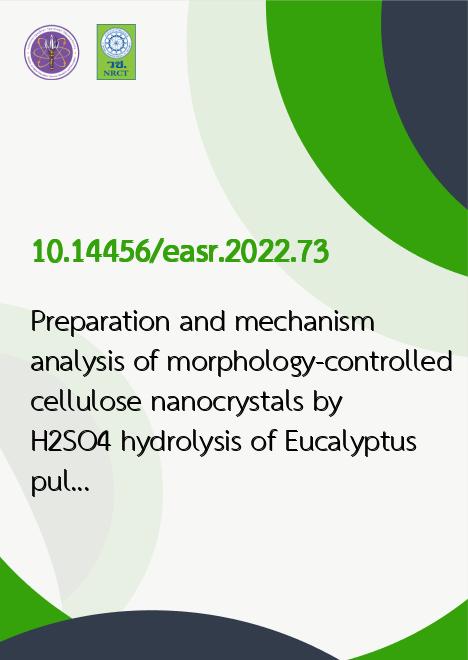
|
Preparation and mechanism analysis of morphology-controlled cellulose nanocrystals by H2SO4 hydrolysis of Eucalyptus pulp |
|---|---|
| รหัสดีโอไอ | |
| Creator | 1. Pasakorn Jutakridsada 2. Somnuk Theerakulpisut 3. Varsha Srivastava 4. Mika Sillanpää 5. Khanita Kamwilaisak |
| Title | Preparation and mechanism analysis of morphology-controlled cellulose nanocrystals by H2SO4 hydrolysis of Eucalyptus pulp |
| Publisher | Faculty of Engineering, Khon Kaen University |
| Publication Year | 2565 |
| Journal Title | Engineering and Applied Science Research |
| Journal Vol. | 49 |
| Journal No. | 6 |
| Page no. | 753-762 |
| Keyword | Cellulose nanocrystals, Eucalyptus pulp, H2SO4 hydrolysis |
| URL Website | https://ph01.tci-thaijo.org/index.php/easr/index |
| Website title | Engineering and Applied Science Research |
| ISSN | 2539-6161 |
| Abstract | Cellulose from Eucalyptus pulp has been used as raw material for producing cellulose nanocrystals (CNCs). In this research work, H2SO4 hydrolysis was utilized in the production of CNCs. The effects of hydrolysis parameters, namely, H2SO4 concentration (30, 40, and 50 wt%), hydrolysis time (30, 60, and 90 min), and hydrolysis temperature (60, 70, and 80 °C), on the CNC structure were examined. The physical and chemical properties of Eucalyptus pulp and CNCs were characterized using different techniques such as X-ray diffraction (XRD), Fourier-transform infrared spectroscopy (FT-IR), scanning electron microscopy (SEM), transmittance electron microscopy (TEM), and thermal gravimetric analysis (TGA). The results showed the optimal condition was at 50 wt% of H2SO4 concentration, 60 min hydrolysis time, and 60 °C hydrolysis temperature, which yielded 75.51% ± 1.51 % of crystallinity and 4.03 ± 0.10 nm of crystal size. Furthermore, it was also determined that an increase in H2SO4 concentration, time, or temperature led to a lower percentage of crystallinity and reduction in crystal size. CNCs were noted to be more thermally stable than the Eucalyptus pulp. Thus, this method could be an alternative way to create a new product in the paper industry. |